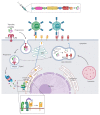An Immunoinformatics Approach for SARS-CoV-2 in Latam Populations and Multi-Epitope Vaccine Candidate Directed towards the World's Population
- PMID: 34205992
- PMCID: PMC8228945
- DOI: 10.3390/vaccines9060581
An Immunoinformatics Approach for SARS-CoV-2 in Latam Populations and Multi-Epitope Vaccine Candidate Directed towards the World's Population
Abstract
The coronavirus pandemic is a major public health crisis affecting global health systems with dire socioeconomic consequences, especially in vulnerable regions such as Latin America (LATAM). There is an urgent need for a vaccine to help control contagion, reduce mortality and alleviate social costs. In this study, we propose a rational multi-epitope candidate vaccine against SARS-CoV-2. Using bioinformatics, we constructed a library of potential vaccine peptides, based on the affinity of the most common major human histocompatibility complex (HLA) I and II molecules in the LATAM population to predict immunological complexes among antigenic, non-toxic and non-allergenic peptides extracted from the conserved regions of 92 proteomes. Although HLA-C, had the greatest antigenic peptide capacity from SARS-CoV-2, HLA-B and HLA-A, could be more relevant based on COVID-19 risk of infection in LATAM countries. We also used three-dimensional structures of SARS-CoV-2 proteins to identify potential regions for antibody production. The best HLA-I and II predictions (with increased coverage in common alleles and regions evoking B lymphocyte responses) were grouped into an optimized final multi-epitope construct containing the adjuvants Beta defensin-3, TpD, and PADRE, which are recognized for invoking a safe and specific immune response. Finally, we used Molecular Dynamics to identify the multi-epitope construct which may be a stable target for TLR-4/MD-2. This would prove to be safe and provide the physicochemical requirements for conducting experimental tests around the world.
Keywords: LATAM; SARS-CoV-2; in silico; vaccine.
Conflict of interest statement
The authors declare that they have no competing interest.
Figures






Similar articles
-
A Proteome-Wide Immunoinformatics Tool to Accelerate T-Cell Epitope Discovery and Vaccine Design in the Context of Emerging Infectious Diseases: An Ethnicity-Oriented Approach.Front Immunol. 2021 Feb 26;12:598778. doi: 10.3389/fimmu.2021.598778. eCollection 2021. Front Immunol. 2021. PMID: 33717077 Free PMC article.
-
Designing an efficient multi-epitope vaccine displaying interactions with diverse HLA molecules for an efficient humoral and cellular immune response to prevent COVID-19 infection.Expert Rev Vaccines. 2020 Sep;19(9):871-885. doi: 10.1080/14760584.2020.1811091. Epub 2020 Sep 24. Expert Rev Vaccines. 2020. PMID: 32869699 Free PMC article.
-
Identification of Novel Candidate Epitopes on SARS-CoV-2 Proteins for South America: A Review of HLA Frequencies by Country.Front Immunol. 2020 Sep 3;11:2008. doi: 10.3389/fimmu.2020.02008. eCollection 2020. Front Immunol. 2020. PMID: 33013857 Free PMC article. Review.
-
Artificial intelligence predicts the immunogenic landscape of SARS-CoV-2 leading to universal blueprints for vaccine designs.Sci Rep. 2020 Dec 23;10(1):22375. doi: 10.1038/s41598-020-78758-5. Sci Rep. 2020. PMID: 33361777 Free PMC article.
-
Immunoinformatics Approach for the Identification and Characterization of T Cell and B Cell Epitopes towards the Peptide-Based Vaccine against SARS-CoV-2.Arch Med Res. 2021 May;52(4):362-370. doi: 10.1016/j.arcmed.2021.01.004. Epub 2021 Jan 29. Arch Med Res. 2021. PMID: 33546870 Free PMC article. Review.
Cited by
-
Design of multivalent-epitope vaccine models directed toward the world's population against HIV-Gag polyprotein: Reverse vaccinology and immunoinformatics.PLoS One. 2024 Sep 27;19(9):e0306559. doi: 10.1371/journal.pone.0306559. eCollection 2024. PLoS One. 2024. PMID: 39331650 Free PMC article.
-
Design of a multi-epitope vaccine against brucellosis fused to IgG-fc by an immunoinformatics approach.Front Vet Sci. 2023 Oct 23;10:1238634. doi: 10.3389/fvets.2023.1238634. eCollection 2023. Front Vet Sci. 2023. PMID: 37937155 Free PMC article.
-
Construction and validation of a multi-epitope in silico vaccine model for lymphatic filariasis by targeting Brugia malayi: a reverse vaccinology approach.Bull Natl Res Cent. 2023;47(1):47. doi: 10.1186/s42269-023-01013-0. Epub 2023 Mar 24. Bull Natl Res Cent. 2023. PMID: 36987521 Free PMC article.
-
Immunoinformatics-Aided Design of a Peptide Based Multiepitope Vaccine Targeting Glycoproteins and Membrane Proteins against Monkeypox Virus.Viruses. 2022 Oct 27;14(11):2374. doi: 10.3390/v14112374. Viruses. 2022. PMID: 36366472 Free PMC article.
-
Mapping Potential Vaccine Candidates Predicted by VaxiJen for Different Viral Pathogens between 2017-2021-A Scoping Review.Vaccines (Basel). 2022 Oct 24;10(11):1785. doi: 10.3390/vaccines10111785. Vaccines (Basel). 2022. PMID: 36366294 Free PMC article.
References
-
- Prompetchara E., Ketloy C., Palaga T. Immune responses in COVID-19 and potential vaccines: Lessons learned from SARS and MERS epidemic. Asian Pac. J. Allergy Immunol. 2020;38:1–9. - PubMed
-
- Adhikari S.P., Meng S., Wu Y.J., Mao Y.P., Ye R.X., Wang Q.Z., Sun C., Sylvia S., Rozelle S., Raat H., et al. Epidemiology, causes, clinical manifestation and diagnosis, prevention and control of coronavirus disease (COVID-19) during the early outbreak period: A scoping review. Infect. Dis. Poverty. 2020;9:29. doi: 10.1186/s40249-020-00646-x. - DOI - PMC - PubMed
-
- Rodriguez-Morales A.J., Gallego V., Escalera-Antezana J.P., Méndez C.A., Zambrano L.I., Franco-Paredes C., Suárez J.A., Rodriguez-Enciso H.D., Balbin-Ramon G.J., Savio-Larriera E., et al. COVID-19 in Latin America: The implications of the first confirmed case in Brazil. Travel Med. Infect. Dis. 2020;35:101613. doi: 10.1016/j.tmaid.2020.101613. - DOI - PMC - PubMed
LinkOut - more resources
Full Text Sources
Research Materials
Miscellaneous

